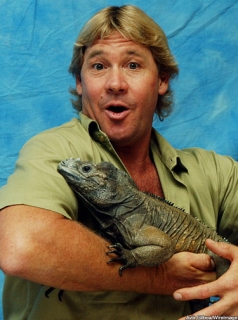Steve Irwin
|
Mostly Credited As: Steve Irwin Birth Name: Stephen Robert Irwin Date Of Birth: February 22, 1962 (Age 44) Country Of Birth: Birth Place: Essendon, Victoria Date Of Death: September 04, 2006 Cause Of Death: Stingray barb to the chest (Port Douglas, AU) Height: 6' (1.82 m) |
 |
Best known for the television program The Crocodile Hunter, an unconventional wildlife documentary series which he hosted with his wife Terri Irwin. He also owned and operated the Australia Zoo at Beerwah in Queensland with friend William Rollo and his wife. Born to Lyn and Bob Irwin in Essendon, a suburb of Melbourne, Victoria, Irwin moved with his parents as a child to Queensland in 1970. Bob was a reptile enthusiast and when the family moved, his parents started the small Queensland Reptile and Fauna Park, where Steve grew up around crocodiles and other reptiles. Steve became involved with the park in a number of ways, including taking part in daily animal feedings, as well as care and maintence activities. On his sixth birthday he was given a scrub python. Bob educated Steve on reptiles, with Steve getting involved physically with crocodiles at the age of 9. He became a crocodile trapper, removing crocodiles from near populated areas, performing the service for free with the quid pro quo that he kept them for the park. Steve followed in his fathers' footsteps, becoming a volunteer for the Queensland Government's East Coast Crocodile Management program. The park was a family business, with Lyn and Bob turning it over in 1991 to Steve. He took over the running of the park, now renamed the "Australia Zoo", and in 1992 met (at the park) and married Terri. The footage, shot by John Stainton, of their crocodile-trapping honeymoon became the first episode of The Crocodile Hunter, which became wildly successful in America and the UK. His exuberant and enthusiastic presenting style, broad Australian accent, constant wearing of khakis and catch-phrase "Crikey!" became known worldwide: The Crocodile Hunter aired in over 122 countries worldwide. Under Irwin's expansive leadership, the operations grew to include the zoo, the television series, The Steve Irwin Conservation Foundation, and International Crocodile Rescue. Improvements to his Australia Zoo include the Animal Planet Crocoseum, the rainforest aviary, and Tiger Temple. In 2001, Irwin appeared in a cameo role in the Eddie Murphy film Dr. Dolittle 2. In 2002, his first feature film, The Crocodile Hunter: Collision Course, was released. In general, reviews of this film were negative. Steve played himself, as well as performing numerous stunts for the film. The film follows Steve who mistakes some CIA agents for poacheres. He sets out to stop them from capturing a crocodile, whom, unknown to him, has actually swallowed a tracking drone. All the crocodiles used in the film were real, and were actually those that had been caught by Steve. The film won the Best Family Feature Film award for a comedy film at the Young Artist Awards. The film was produced on a budget of around $13,000,000. It performed well at the box office, taking in just under three times it's budget.[1] In 2003 Irwin was reportedly in line to host a chat show on Australian network television, a series that never went into production. Animal Planet then released a Crocodile Hunter special called "Crocodiles & Controversy", which attempted to explain both the "Baby Bob Incident" and the Antarctica incident (see below). This special argues that Irwin's son was never in danger of being eaten by the crocodile, and that Irwin could not have endangered animals in Antarctica. Animal Planet ended The Crocodile Hunter with a series finale entitled "Steve's Last Adventure". The last Crocodile Hunter documentary went for three emotional hours with footage of Irwin's across-the-world adventure, visiting locations like the Himalayas, the Yangtze River, Borneo, and the Kruger National Park. On 4 September 2006, Irwin was fatally pierced in the chest by a stingray barb, while off the Great Barrier Reef in Queensland, Australia while filming a segment for his daughter Bindi Irwin's (8 years old at the time) upcoming series. Irwin was in the area filming his own documentary, to be called Ocean's Deadliest, but weather had stalled filming. Irwin decided to take the opportunity to film some shallow water shots for his daughter's program. The BBC reported that this was only the second known fatality in Australian history from a stingray attack. The Sydney Morning Herald lists it as the third known death; the other two deaths being in 1938 and 1945.
TV Appearances
| Main cast | ||||||||||||||||||||||||||||||||||||||||||||||||||||||||||||||||||||||||||||||||||||||||||||||||||||||||||||||
| ||||||||||||||||||||||||||||||||||||||||||||||||||||||||||||||||||||||||||||||||||||||||||||||||||||||||||||||
| Episode Cast Credits | ||||||||||||||||||||||||||||||||||||||||||||||||||||||||||||||||||||||||||||||||||||||||||||||||||||||||||||||
| ||||||||||||||||||||||||||||||||||||||||||||||||||||||||||||||||||||||||||||||||||||||||||||||||||||||||||||||
Latest news
There are no news items yet
Trivia
No trivia added for this person
No trivia added for this person
Steve Irwin Quotes
No quotes added for this person
No quotes added for this person

